 |
 |
 |
| |
Five Million Americans Infected with the Hepatitis C Virus: A Corrected Estimate
|
| |
| |
Reported by Jules Levin
http://www.natap.org
study authors:
Brian Edlin, MD
Marla Shu, MPH
Yolanda Barron-Vaya, MS
Center for the Study of Hepatitis C, Weill Medical College of Cornell University
Dr Edlin presented the results of his study in an oral session at AASLD Nov 2005.
Estimates of the number of persons with hepatitis C in the United States are important for assessing the magnitude of the pandemic, designing and targeting public health interventions, and planning for future health care needs.
The number of persons infected with the hepatitis C virus in the United States has been estimated by testing blood specimens from the National Health and Nutrition Examination Survey. Results from 1988-1994 were published some years ago, and an analysis of more recent data was recently completed by Armstrong and colleagues will be published in the coming months. Both datasets suggested that about 4 million persons (± a million) have antibody to HCV, so have ever been infected, and about 3 million have HCV RNA, so currently remain infected.
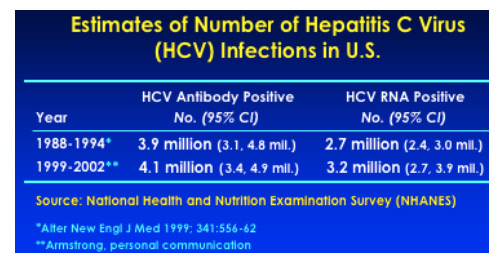
NHANES is an enormously valuable study. But it is a study of the noninstitutionalized, civilian population of the U.S. Several large populations at increased risk of HCV infection are excluded from the NHANES sampling frame. Specifically, it does not include persons who are homeless, incarcerated or hospitalized, nursing home residents, and active-duty military.
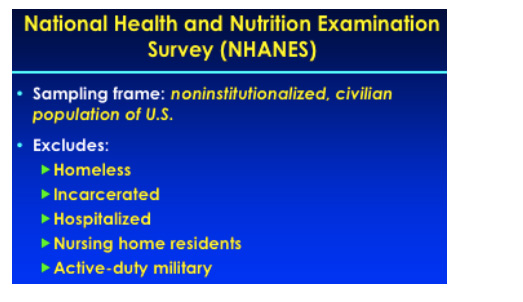
We obtained estimates of the size of these populations during 1999-2002 from the agencies and surveys listed on this slide.
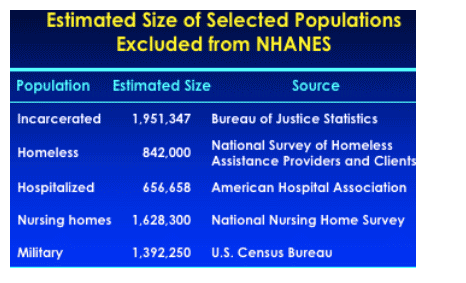
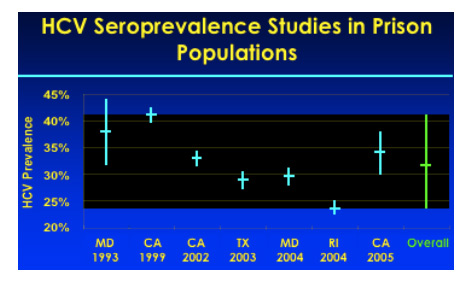
We obtained estimates of the prevalence of HCV antibody in each of these populations by searching the medical literature. No nationally representative samples of any of these five populations are available. But 7 studies of HCV seroprevalence among persons entering correctional facilities in four states have been published. The studies differed in sample design and methodology. The prevalences and associated 95% confidence intervals are shown on this graph. While these four states cannot be considered representative of the U.S. as a whole, it is worth noting that California and Texas together account for about 24% of the nation’s prisoners. The pooled prevalence of HCV antibody among all persons in all studies combined was 32%. The prevalences in the 7 studies ranged from 23% through 43%. To be conservative, we used this range to represent the uncertainty in our estimate of the overall prevalence of HCV among prisoners in the United States.

Six studies of HCV seroprevalence among homeless persons have been published. The study design and selection criteria differed in each study. The pooled prevalence of HCV antibody among all persons in all studies combined was 34.5%. The prevalences in the 6 studies ranged from 22% through 53%.

Seven studies of HCV seroprevalence among persons in hospitals have been published. Two studied source patients of needlestick injuries; 2 were conducted in emergency rooms and one in a psychiatric hospital, but the HCV antibody prevalences were between 12% and 21% in all the studies. The pooled prevalence of HCV antibody among persons in all these studies combined was 17%.

We found only one small study of HCV seroprevalence in nursing home residents, and one large study of HCV seroprevalence in the active-duty military.
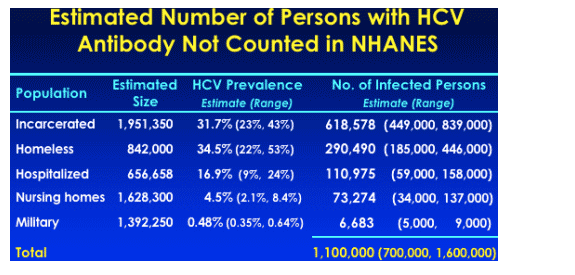
We then multiplied the estimated no. of persons in each population by the estimated seroprevalence in that population and obtained estimates of the number of HCV-positive persons in each group. Summing these, we calculated that there may be about a million persons with HCV antibody in addition to the NHANES estimate. The largest contributions to this number were from incarcerated and homeless persons.
Adding these numbers to the most recent NHANES estimates suggests that about five million people in the U.S. may have HCV antibody.
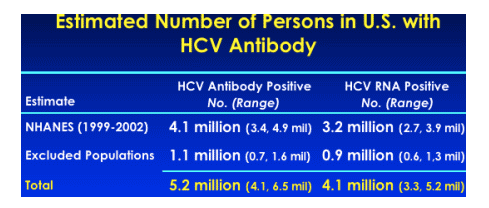
We used the most recent NHANES estimate that 80% of persons with antibody have RNA, and projected that approximately four million persons in the U.S. are currently infected.
LIMITATIONS
--samples not representative
--no precise estimate of homelessness
--only 4 state prison systems, 6 homeless studies, 7 hospitals
--publication bias
These findings cannot be considered precise because of several major limitations to our procedures.
First, there are no representative samples of most of the populations examined. The seroprevalence studies we used were not designed to recruit nationally representative samples.
Second, there is no precise estimate number of the homeless persons in the U.S.
Third, HCV seroprevalence studies have been published in only 4 state prison systems, 6 homeless samples, and 7 hospitals.
And finally, studies showing higher prevalence rates may have been more likely to be published, which would have biased our estimates upward.
Additional Sources of Potential Undercount
--persons with unstable and temporary housing
--uncounted persons
--incomplete blood specimen collection
--loss of HCV antibody
Balanced against this possible overestimation are several reasons the current study may still be underestimating the number of infected persons.
First, several studies have suggested that persons in temporary or unstable housing may outnumber those who are literally homeless on any given night by 3- or 4-fold. Persons not in their “usual place of residence” were not included in NHANES. These persons could account for another half million to one million additional persons with HCV antibody.
Second, national household surveys miss people. Studies of the U.S. Census coverage, for example, estimated that ~ 3-4 million people were uncounted, who are disproportionately young, male, poor, of minority race/ethnicity, and likely to have a higher than average HCV prevalence. National household surveys such as NHANES are likely to have similar coverage limitations.
Third, about a quarter of NHANES participants did not provide a blood specimen. This group may have included an unknown number of injection drug users not wishing to reveal needle tracks or to undergo what may have been a painful phlebotomy experience.
And finally, we need to bear in mind that antibody levels wane in persons who clear HCV infection. A recent study suggested that 26% of young women who cleared an acute infection were antibody negative 25 years later.
For these reasons, the findings presented here may still underestimate the true number of HCV-infected persons in the U.S.
CONCLUSIONS
--five million persons in the US (or more) have HCV antibody
--at least 4 million have HCV RNA
--surveillance systems need representative samples of disenfranchised populations
--projected burden of liver disease in the coming decades may be underestimated.
The estimates presented here are certainly less precise than the NHANES estimate, but they are likely to be more accurate. The number of persons in the U.S. who have been infected with HCV is probably closer to 5 million than 4 million, and it may be higher still.
The number of persons currently infected with HCV is probably at least 4 million.
In addition, it is important to recognize that household surveys are an incomplete source of information about the prevalence of conditions affecting disenfranchised populations. To be accurate, surveillance systems need to recruit representative samples of socially marginalized populations, to estimate disease prevalence and evaluate interventions for these groups.
For the meantime, our current projections may underestimate the burden of liver disease in the coming decades.
|
|
| |
| |
|
 |
 |
|
|